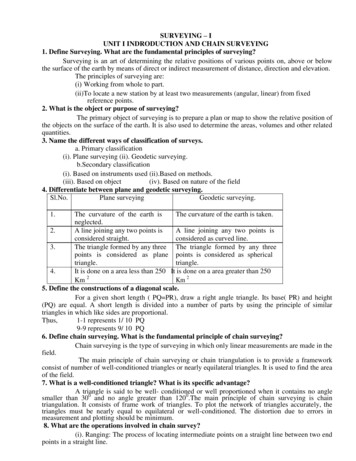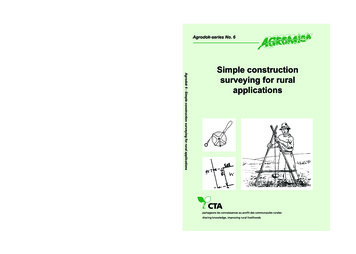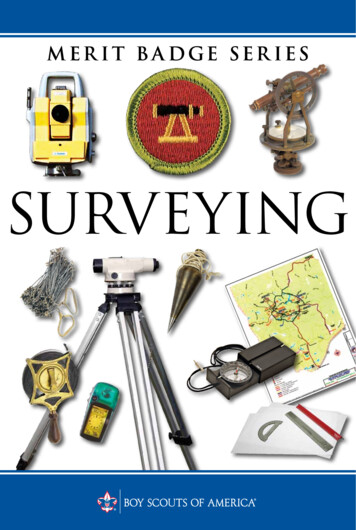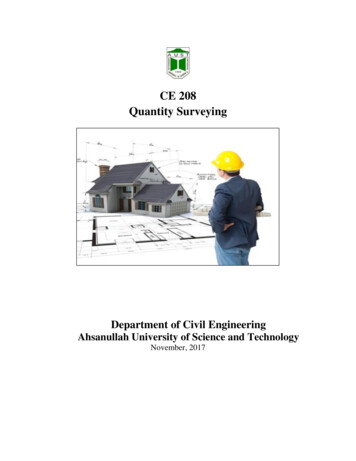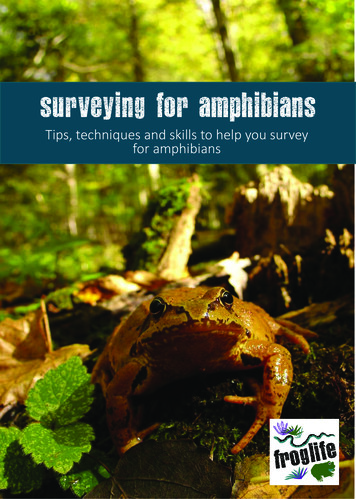
Transcription
surveying for amphibiansTips, techniques and skills to help you surveyfor amphibiansfroglife
‘Surveying forAmphibians’ is ahandy guide whichsummarises key IDfeatures of commonamphibian species,and provides youwith important tips,techniques and skillsto help you surveyfor these amazingcreatures.Cover image: Common Frog /SilviuPetrovanFroglife is a registered charity in England& Wales (no.1093372) and in Scotland (no.SC041854). Froglife is concerned withthe protection and conservation of nativeamphibians and reptiles and the habitatsthey depend on. Froglife 20151st Edition printed 2016Paper sourced from FSC-certifiedsustainable forestsWritten by Froglife: Alex DraperEdited by V. Barber & V. LarcombeDesigned by Vanessa BarberPhotos: Froglife unless otherwise stated.1Contents2: Surveying for Froglife3-6: Species identification7-8: When to look foramphibians9-13: How to look foramphibians14-15: How often to survey16-18: Biosecurity19: Personal safety and legality20: Useful websites21: Using the survey form22-27: Amphibian survey forms
Surveying for FroglifeWhy should I survey?It’s great fun and gets you outdoors among nature!On top of that good survey data allows Froglife to:verify presence or likely absence;monitor distribution and population change;inform site management;monitor for non-native species;monitor for spread of disease and/or evidence of persecution;contribute data to local biological recording centres.Where should I send my survey data?Survey data can be recorded using our paper survey forms orvia Froglife’s Dragon Finder app (search for ‘Dragon Finder’ inthe App Store or Google Play).Alternatively you can send your data directly to Froglife.We pass all of our data to local biological record centres.Remember - surveys with ‘zero’ or likely absence results are stilluseful data to us!This booklet contains two survey forms. If you requiremore forms please ngSend your forms to:Froglife, 1 Loxley, Werrington, Peterborough, PE1 4BW2
Species identificationThese pages cover the native UK amphibian species in theiradult form.For non-native species, information oneggs and larvae, or further help withidentification please visit:www.froglife.org/amphibians-andreptilesor download the new version of our freeDragon Finder app, available on iPhoneand Android.NewtsPalmate NewtAdults up to 9cm in length.Smooth skin that is brown,green or grey.Yellow belly, often withdark spots. Unspotted pinkor yellow throat (unlikeSmooth Newts, whichhave spotted throats).During the breedingseason males develop afilament at the tip of theirtail and black webbing ontheir back feet.3
Great-Crested NewtAdults up to 15cm inlength.Skin is black or darkbrown and has a rough,‘warty’ appearance.Underside is brightorange with irregularblack blotches.Males have a crestalong their backs whichis more pronouncedduring the breeding season.Males have a white flashalong the centre of the tail andfemales a yellow/orange one.‘Warts’ along the side of the body may have white tips.Largest newt species in the UK.Smooth NewtAdults up to 10cm in length.Skin is varying shades ofgrey or brown. Malesdevelop a wavy crestalong the back duringthe breeding season.Belly yellow ororange, usually withblack spots and/orblotches.Throat is spotted.Males have a whiteflash along the bottom oftheir tail.
FrogsCommon FrogAdults males grow up to 9cmin length and females up to13cm in length.Usually a shade of olivegreen or brown (althoughcan be yellow, pink, red,lime-green, cream orblack).Dark patches on theback, stripes on the hindlegs.A dark ‘mask’ behind theeye.Oval, horizontal pupil.Call: soft repetitive croak.Pool Frog5Adult females up to 9cm inlength. Males significantlysmaller.Brown or green with darkblotches across the backand a cream or yellowdorsal stripe.Pair of ridges run fromthe eyes down the back.Vocal sacs visible eitherside of the mouth ofbreeding males.Oval, horizontal pupil.Call: a loud call, oftenlikened to ducks quacking orrapid laughter ‘re re re’.
ToadsCommon ToadAdults males grow up to 8cm inlength, adult females are largerwith reports of up to 13cm inlength.Generally brown orolive-brown but may bedarker.Belly usually pale withdark speckles. Skin is‘warty’ and relativelydry.Oval, horizontal pupil.Many individuals havea golden iris.Tend to crawl rather thanhop.Call: high-pitched, rough“qwark-qwark-qwark”.Natterjack ToadAdults up to 8cm in length.Green, brown or cream.Dark ‘warts’ on theirbacks often with yellow orred tips.Obvious pale cream/yellow stripe along back.Green iris with oval,horizontal pupil.Short legs.Run rather than walk orhop.Poor swimmers.Call: a loud rasping rollingcroak ‘errr errr errr’. Canbe heard from up to 2km away onquiet nights.
When to look for amphibiansUK amphibians are most activeduring the breeding season(generally March - May),and will be spotted in andaround standing water. Overthe summer and into earlyautumn most amphibians willtake shelter on land duringthe day, coming out to feed atnight. Some may occasionallyrevisit ponds: ‘Green’ frogsespecially will stay close towater. In winter amphibians willfind deeper frost-free shelter tohibernate in until the followingspring.7Common FrogMid Feb - MarchCommon ToadMid March - April
Where to lookfor amphibiansUK amphibians requirestanding water for breeding.Therefore any suitable pondor ditch is a good place tostart looking. They will alsoshelter beneath, rocks, logs,and in crevices which provideprotection from predators,and from exposure duringcolder months.Newt speciesMid April - JuneGreen/ water frogsMay - June8
How to look for amphibiansYou can use three main techniques for surveyingamphibians:1. Visual search of pond and surrounding area2. Netting in pond3. Torching in pondVisual searchDuring the daytime, simply walk around the pond edge andsurrounding terrestrial habitat looking for:Amphibians in the water – including tadpoles and newt efts.Amphibians under refugia such as logs and large stones.Remember amphibians can travel several hundred metres awayfrom pond, so look further afield too.Eggs laid by newts on submerged plants during April – May.Inspect artificial egg laying strips if in use (page 12).Look for spawn (clumps for frogs and strings for toads) duringMarch – April.Amphibian poo and prints are too difficult to spot so aren’t usefulfor surveying purposes.6 9
NettingYou will need a net with a rigid frame anda mesh of approximately 2mm.How to net:Net from the bank of the pond - do notoverreach!Stop every two metres and sweep thenet in a strong agitating motion throughvegetation at the pond edge.Inspect your catch in the net.Avoid handling animals and return themto the water quickly. Alternatively, put thematerial from the net into a white ‘dipping’tray containing pond water for closerinspection.Move to the next two-metre stretch andrepeat.Froglife recommends 15 minutes ofnetting per 50 m of bankNetting can be useful for detecting:Adult newts (especially palmate andsmooth newts), frog and toad tadpoles.Common from March to May.Newt larvae. Common from August toSeptember.Fish and other invertebrates year round.Warning: Excessive netting can bedamaging to vegetation and will stirup silt which might reduce visibilityfor torching later that same day. Youshould stop once all species havebeen identified to reduce the impacton the pond.10
Searching for newt eggsNewt egg searches should be conducted April to May.Inspect submerged aquatic plants or artificial egg laying stripscarefully. Look for folded leaves/strips where newts have laid theireggs.Carefully unfold a leaf/strip to see if it contains a white/yellowishegg (Picture 1: great-crested newt) or grey/brownish egg (Picture2: smooth or palmate newt).Unfold the minimum number of leaves/strips necessary.Stop immediately if you discover great crested newts eggs(these are a protected species and require a license to surveyfor).12Artificial egg stripsIf your pond has little suitable vegetation for egg laying or haslimited visibility for torching (eg: lots of duckweed) then you mightconsider using artificial egg laying strips. Newts will lay their eggson these just as they would submerged plants. We recommendinstalling them in groups of 5, appoximately 1-2m apart for every25m of pond edge. Make sure they are fully submerged or justbreaking the surface in ’duckweedy’ ponds. Seek permission fromthe landowner before putting out artificial egg strips. When youcheck them for eggs remember to place them back in the water toallow the eggs to hatch. Remove the strips in August/September.11
How to makean egg stripCut a black or green bin bagacross the joined sides tocreate strips that are about30mm deep. Cut off one ofthe joined sides. Then cutlengthways into 1-2cm widestrips up to about 50mm fromthe remaining joined side. Youshould end up with a strip witha fringe of long tassles. Wrapthis around the end of a stick(length depending on ponddepth) and secure with a staple.12
TorchingNewts are most active after dark, and a powerful torch is aneffective way to spot them in open water.The torchlight surveys are optional. Please consider the safetyaspects associated with this method (page 17).You will need a powerful torch in the range of 500,000 to 1 millioncandlepower. Torches made by Cluson Engineering are popular,but any sufficiently powerful torch may be useful.How to torchThe pond should be searched by torchlight from the banks – youshould not go into or disturb the water surface.Move slowly and torch approximately every two metres.Shine the torch in the water, moving out from the bank and backagain slowly – take time to get your ‘eye in’.Keep a tally of the number of amphibians seen in the whole pond(peak counts can be used to estimate population size).Warning: Never undertake a torching survey on your own13P
How often to surveyDaytime:March-April: Spawn count for common frogs and toadsApril-June: Egg searches for newtsMay-June: Visual/call search for introduced water/green frogsMarch-September:Refugia searchingNight-time:March-June: Torching for all amphibians particularly newtswhich are more active at nightJuly-September: Torching for newt larvae hatched that yearN.B. These timings are general and amphibian activity will varywith geographic location and weather conditions.Ideal surveying conditions for torching:Air temperature 5 C or warmer (warmer evenings are optimal).Avoid surveying at night directly after a cold spell.Little or no wind.Dry (although very light rain is tolerable).Water temperature ideally 10 C or more (this can be hard tomeasure without special equipment)14Photo: Glenn Upton-Fletcher
Four surveys is optimum number for a presence/absencesurvey. For ponds that are difficult to survey, for examplethose with dense aquatic vegetation and/or poor water quality,then six is preferable. If only one survey is possible then dothis during May and use as many techniques as possible.visit 1March - earlyApril15visit 2Mid April -midMayvisit 3Late May end JuneVisit 4Aug -Sept
laPndyg m y w ee dZeaBiosecurityNewThere are a number of highlyinvasive non native aquaticplants established in the UK.These can be easily spreadthrough fragments of theplant which will then growand establish quickly. Plantsthat fall under this categoryare:tewarwe edianThe invasive plant problemNuttall’s pondweed(Elodea nuttallii)CanadCanadian waterweed(Elodea canadensis)Curly waterweed(Lagarosiphon major)Water Fern(Azolla filiculoides)teaherFlowering Water Primrose(Ludwigia grandiflora)Floating Pennywort(Hydrocotyle ranunculoides)P a rro t’sFNew Zealand Pygmyweed(Crassula helmsii)Parrot’s Feather(Myriophyllum aquaticum)2216
The disease problemIn the UK there are two significant amphibian diseases,Ranavirus and Chytridiomycosis.These can cause mass mortalityevents in amphibian populations.Ranavirus:A viral infection, primarily affects common frogs (but has beenidentified in common toads and smooth newts). Symptomsinclude emaciation, lethargy and haemorrhaging. Outbreaks areoften seen during hot summers.Com mon fro gwithChytridiomycosis:Ras17v ir uYou can report amphibian health incidents and get moreinformation from the Garden Wildlife Health project:www.gardenwildlifehealth.orgnaAlso known as chytrid, hasbeen found to affect allnative amphibians tovarying degrees and iscaused by the fungusBatrachochytriumdendrobatidis (oftenreferred to as Bd or chytridfungus). Bd grows on theamphibian’s skin causingproblems with respiration andwater uptake. It can often affectemerging juvenile amphibians. Anew chytrid fungus affecting salamanderspecies (B. salamandrivorans) has recently been foundin continental Europe and captive UK populations.
Safeguard the environment - CHECK, CLEAN and DRY:Precautions should be taken to avoid the potential spread ofdisease between reptile and amphibian populations and thespread of non-native plants and animals.CHECK all equipment to remove fragments, seeds and liveorganisms.CLEAN and wash all equipment thoroughly after every pondvisit.DRY all equipment as some pathogens can survive for severaldays or even weeks in damp conditions.Take special care where sites are known to have disease and/orinvasive species issues. Check, clean and dry between each site/pond sampled.If there is more than 1km between sites then also disinfect allequipment and footwear.The recommended disinfectant is Virkon. Soak equipment forone minute in a 1mg/1ml solution, or apply using a spray bottle.Alternatively a 1:15 bleach (5% bleach content) solution can beused (soak for 15 minutes).In general try to avoid handling amphibians. If you doneed to handle amphibians or pond water use a new pairof disposable vinyl gloves for each site sampled. Do notuse latex gloves as they are harmful to amphibians.18
Personal safetyCarry out a site risk assessment for the site you plan to survey.Identify additional specific hazards associated with the site. Forexample, steep slippery banks.Do not carry out a survey if you feel unsafe to do so.Always talk to the landowner of the site to gain permission tosurvey.Try to survey with another person and let others know whereand when you are surveying. Do not carry out night surveysalone.LegalityAll native amphibians are protected under the Wildlife andCountryside Act 1981 against sale or trade.The great-crested newt (GCN) is a fully protected speciesunder UK and European law. This means it is an offence to:capture, kill, disturb or injure great-crested newts (on purpose orthrough negligence), to damage or destroy a breeding or restingplace (even accidentally), to obstruct access to their resting orsheltering places (on purpose or by not taking enough care),and to possess, sell, control or transport live or dead newts, orparts of them. This protection covers the newts as eggs, larvae,juveniles and adults.All surveys for great-crested newts must be undertaken underlicence from Natural England. Without a license (for Englandthese are issued by Natural England and requires training andfield experience to qualify for) you will not be able to survey a sitethat you know to have GCN present. If you identify the presenceof GCN at a site and you do not hold a license then you muststop your surveying activity immediately.19
Useful websitesCheck, Clean Dry campaign: www.nonnativespecies.org/checkcleandry/Non-native pond plant specieswww.nonnativespecies.org//beplantwise20
Using the survey formWhat are we recording?Site details: Site name, address and grid reference if possible.Survey conditions:Temperature ( C)Current weather and weather pattern of previous few daysWater clarity (if known)Setting: Urban, suburban or rural?Other information: Use this section to make a note of other importantfeatures such as nearby rail tracks, presence of livestock (dogs too),evidence of vegetation management (i.e. mowing regime).Species records:Identify the species and lifecycle stage if possible – this helps todetermine if breeding is occurring.Tick if present or add numbers where possible – add a questionmark if unsure.Note where seen – on log, along path, refugia etc.Notes: Use this section to record habitat features of interest. Thiscould include adjacent land use, hibernation/egg laying sites, habitatcondition etc.Fill in a new amphibian survey recording form for every survey youcomplete. Do this in situ, or immediately after you survey – you willforget otherwise! Please send us all of your surveys even thosewhere you found nothing.This booklet contains two survey forms. If you require moresurvey forms please nd your forms to: Froglife, 1 Loxley, Werrington,21Peterborough PE4 5BW
Amphibian Survey formRecorder detailsName:Site detailsName:Address:Address:Telephone number:Email address:Grid Reference:Survey conditions:Date:Time:Air Temperature:Weather conditions:Water clarity:Setting (please tick):UrbanSuburbanRuralHabitat Types Present (please ownfieldMarshOtherPondPondPond(0.26-2.0( 0.25 HA)(Up to 0.25HA)HA)24Other information:24Ditch/StreamHeathlandLake(2.0 HA )
MaleAdultsFemale UnknownLarvae/EggsJuvenilesDeadMethodsDiseased *SurveyNotes:NewtsSmooth newtPalmate newtGreat crested newtOther (please specify)Frogs and ToadsCommon frogGreen/water frogCommon toadNatterjack toadOther (please specify)Other (please specify)*Survey methods: Visual search (V), Netting (N), Torching (T), Refugia (R). Refugia type: Natural (N), Tin(T), Onduline (O), Felt (F).Species2
Amphibian Survey formRecorder detailsName:Site detailsName:Address:Address:Telephone number:Email address:Grid Reference:Survey conditions:Date:Time:Air Temperature:Weather conditions:Water clarity:Setting (please tick):Urban2424SuburbanRuralHabitat Types Present (please ownfieldMarshOtherPondPondPond(0.26-2.0( 0.25 HA)(Up to 0.25HA)HA)Other information:Ditch/StreamHeathlandLake(2.0 HA )
MaleAdultsFemale UnknownLarvae/EggsJuvenilesDeadMethodsDiseased *SurveyNotes:NewtsSmooth newtPalmate newtGreat crested newtOther (please specify)Frogs and ToadsCommon frogGreen/water frogCommon toadNatterjack toadOther (please specify)Other (please specify)*Survey methods: Visual search (V), Netting (N), Torching (T), Refugia (R). Refugia type: Natural (N), Tin(T), Onduline (O), Felt (F).Species
26
Froglife is a UK wildlife charitycommitted to the conservationof amphibians and reptiles- working with people,enhancing lives together for ahealthier planet.Froglife1 LoxleyWerringtonPeterboroughCambridgeshirePE4 5BWThis edition of Just Add Water has beensupported byEmail: info@froglife.orgwww.froglife.org01733 602102If you would like to become a Froglife Friend pleasefill in this form, detach and post it to: Froglife, 1Loxley, Werrington, Peterborough, Cambridgeshire,PE4 5BWNameAddressGet Frog Friendly:become a froglifefriend!Join Froglife today and help us give a voiceto the UK’s amphibians and reptiles - savingspecies, improving habitats and enhancing livesin the process.PostcodeContact Tel.EmailLevel of Froglife Friendship: 18 - annual single Friendship 36 - annual joint or family Friendship 500 Friend for LifeI am a UK taxpayer. Froglife (registered charity no.1093372) can benefit from Gift Aid on my donation.SignedI would like to pay by:DateChequeCard (see below)Card No. (long number on front)Start DateFor as little as 18 for a year you receiveregular newsletter updates, exclusive invites toFroglife events and special offers for Frogaloguemerchandise.Three ways to join:Online: www.froglife.orgBy post: add your details to the left, including acheque or your card details, detach and postit back to usGive Froglife Friendship as a gift:visit the online shop www.froglife.org/shopExpiry DateIssue No. (if present)Name on cardAddress (if different from above)Security Code(last three digits on reverse)27
or download the new version of our free Dragon Finder app, available on iPhone and Android. Palmate Newt. Adults up to 9cm in length. Smooth skin that is brown, green or grey. Yellow belly, often with dark spots. Unspotted pink or yellow throat (unlike Smooth Newts, which have spotted throats). During the breeding season males develop a
